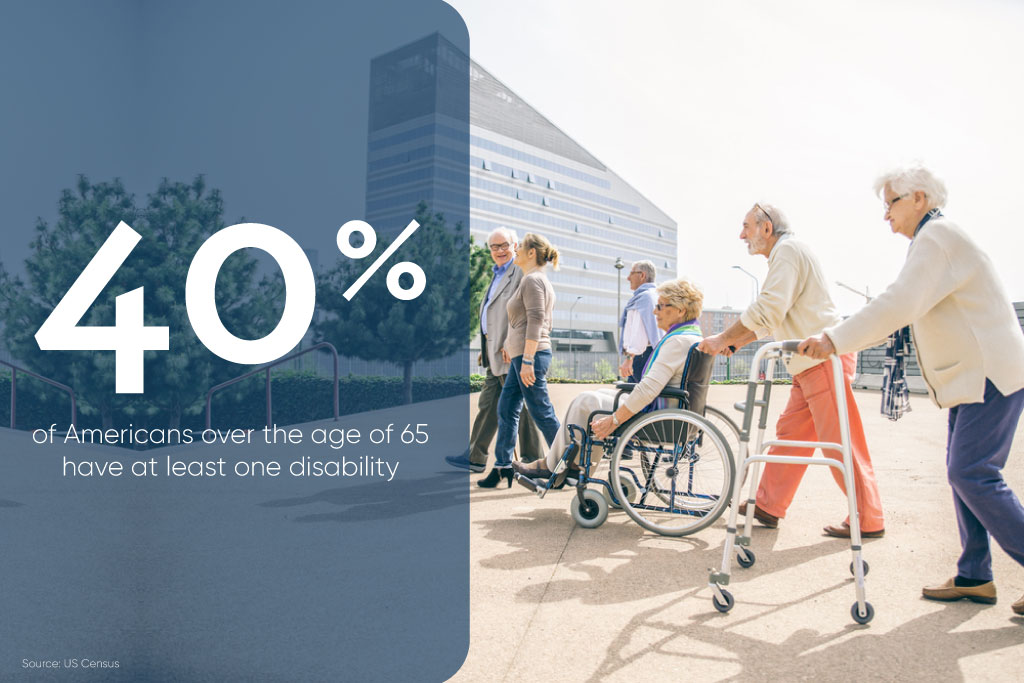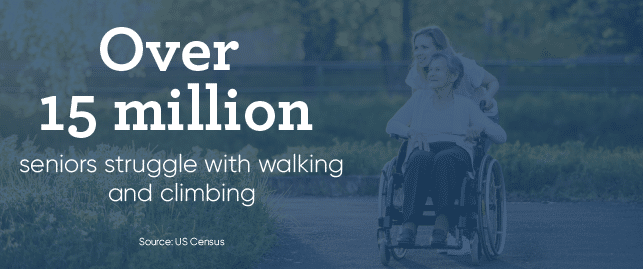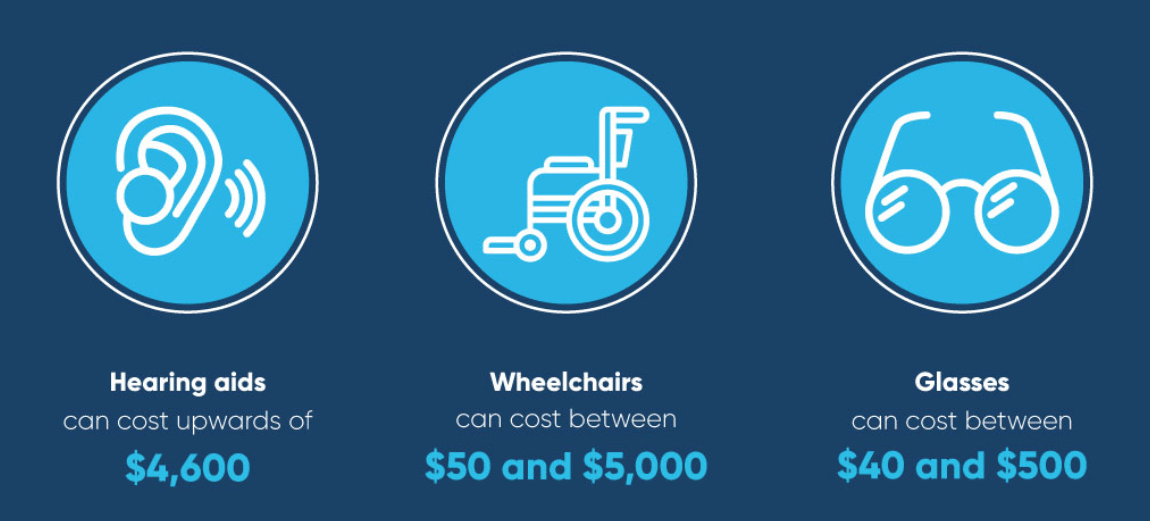KEY TAKEAWAYS
- Assistive technologies can help seniors live a more full, active life.
- There are three main categories of assistive technology:
- Mobility technologies that help keep people moving.
- Sensory techs that allow them to see or hear if they are impaired.
- And cognitive technologies that help users’ memories.
- Prices can vary, with some assistive technologies being relatively cheap (like a cane or walker) compared to more expensive ones (electric wheelchairs and some hearing aids).
As the years progress, many seniors find that performing the same activities they could once do with ease becomes increasingly difficult—whether that’s taking a long walk, listening to music, or reading the morning news. In fact, 40% of American seniors have at least one disability. Although this is perfectly natural, it can be nonetheless frustrating. In retirement, many seniors want to be able to live life to the fullest, enjoying retirement hobbies, athletic activities, and simple pleasures they have so much time to engage in.  Assistive technology devices can help. In this post, we will cover the basics that every senior should know about assistive technology – from electric scooters to hearing aids, and more. Start here and read through for a more complete look, or, just click on one of the links below to go straight to the technology that interests you most.
Assistive technology devices can help. In this post, we will cover the basics that every senior should know about assistive technology – from electric scooters to hearing aids, and more. Start here and read through for a more complete look, or, just click on one of the links below to go straight to the technology that interests you most.
What is assistive technology?
According to the federal Individuals with Disabilities Education Act, assistive technology is equipment that is used to maintain or improve the functional abilities of those with disabilities. Assistive technology can be of help to anyone with a disability and is often used to help children with physical or learning difficulties keep up in school.  Assistive technology is used to help people of all ages, including seniors who may lose mobility or sensory capabilities over time. As a basic overview, assistive technology includes devices such as:
Assistive technology is used to help people of all ages, including seniors who may lose mobility or sensory capabilities over time. As a basic overview, assistive technology includes devices such as:
- Wheelchairs and walkers
- Hearing aids and glasses
- At-home mobility
- Memory-aiding applications
- Text-to-speech software
When planning for health care, it’s important to consider what types of assistive technologies are best for a senior’s unique needs. As these technologies can range from affordable to more expensive, having a plan for purchasing assistive technology is key. We will cover all that and more in sections below.
What kinds of assistive technology exist?
There’s a wide range of devices that can be considered assistive technologies, divided into three different categories: mobility, sensory, and cognitive assistant devices.
Getting Started with Reverse Mortgages
If you’re looking to get started with a reverse mortgage, these articles can help guide you through all aspects of the process.
Guide to HECM Loan Reverse Mortgage Limits
Mobility assistance technology
Mobility can be one of the most frustrating struggles for many retirees. In fact, according to the US Census, mobility is the most common form of disability among seniors—over 15 million seniors struggle with walking or climbing. Luckily, there has been significant development in mobility-improving technology that makes getting around the house—or around town—significantly easier for seniors with disabilities. Finding the right mobility-improving tech depends on what specific disability a senior may experience as there is a wide variety. Here are a few common options:
- Scooters, wheelchairs, and walkers: Seniors who need help moving around, whether it’s from the living room to the kitchen or from the parking lot to the store, often use low-tech assistive technology like scooters, wheelchairs, and walkers. These assistive technology devices can increase a senior’s independence and ability to get around wherever they please.
- Home mobility options: Getting in and out of bed, in and out of the bath, or on and off the toilet can be a struggle for some seniors. Assistive technologies exist to aid in this kind of mobility. These can be fairly simple low-tech assistive technology, but they can have a huge effect. Simply adding handrails to a bathtub, or a system that raises a bed to allow seniors to sit upright can significantly improve quality of life.
- Prosthetics: Seniors who have experienced an amputation can, in many cases, be fitted with a prosthetic limb. These are some of the most expensive and high-tech assistive technology devices, and the engineering work supporting prosthetic limbs is constantly advancing. In the near future, prosthetics may be able to help seniors regain significant amounts of mobility; this technology is certainly something to keep an eye on.
Mobility is just one area in which assistive technology can improve the lives of seniors. If you struggle with another concern, keep reading to learn how modern devices may be able to help. 
Sensory assistance technology
Many seniors may experience a decline in their hearing or vision as they age. Glasses are usually an easy fix for vision problems, but hearing can be a little trickier. Those who are hard of hearing may consider getting hearing aids which come in a few different forms:
- Completely-in-canal is the smallest and least visible. They are less likely to pick up excessive wind, but they might not allow for volume control. Because of their small size, they may need to be recharged more frequently than options that allow for larger batteries.
- In-the-ear hearing aids are larger and fill a portion of the outer ear. They’re often easier to handle due to their larger size and may allow for features like volume control. Because of their larger size, however, these are often more clearly visible.
- Behind the ear aids are the largest and most universally usable variety. The main portion of the device is hooked on behind the ear, with a small bit of tubing fed into the ear canal. These allow for volume control and other features and are well-suited to those with more advanced hearing loss.
For those with eyesight difficulties, glasses are usually the most helpful solution. There are two primary ways in which eyesight is often impaired in seniors:
- Nearsightedness: Those who are nearsighted may have difficulty seeing details at a distance. This form of sight impairment often develops from a younger age, but seniors may notice their distance sight degrading with time too.
- Farsightedness: Farsighted people have trouble focusing vision on detail that is close up. This is more common in adults and seniors and is very likely to develop as a person ages.
In either case, corrective lenses—contacts or glasses—are the assistive technology required. It’s also possible to be afflicted with both conditions, in which case bifocals may be called for. These conditions can be complicated by astigmatism, cataracts, and other eye ailments which may require more advanced treatment or supportive care.
Those with vision impairment may also benefit from speech-to-text and text-to-speech software. This allows users to either dictate desired text to the computer program, which is useful for internet browsing and emailing or have text read to them, which is useful for hearing responses. If vision is not totally impaired, the accessibility functions on many devices can be used to enlarge text for ease of reading.
Cognitive assistance technology
Seniors who experience cognitive difficulties later in life may find that using assistive technology improves their day to day experience. Those with conditions like Alzheimer’s or dementia may have trouble orienting themselves and remembering important details, like taking prescribed medication. It takes trial and error to discover which method works best for a given senior, but these are a few common options, suggested by North Dakota Assistive Technology:
- Watches and timers can be used to help seniors remember the time for important events. Phone app timers and watches with times can be used to remind seniors to take medication, for example, or of a coming date or appointment.
- Calendar apps are similarly important. Seniors may have trouble remembering doctor’s appointments, or time intended to spend with loved ones. Using a calendar app with an alarm feature can help them recall.
- Journaling apps, if keeping a physical journal is too cumbersome, a journaling app can be helpful for those who wish to write down and remember significant events. Keeping a journal on a phone, rather than paper, also reduces the total number of objects a senior has to remember.
- Photo apps, especially those that allow photos to be grouped by persons in the photos, can be crucial for remembering the faces of friends and loved ones. In the later stages of Alzheimer’s and dementia, even remembering these details can be difficult, and having photos can help jog a senior’s recollection.
How much does assistive technology cost?
The cost of assistive technology can vary significantly, from $50 for a walker to tens of thousands for a high-quality prosthetic. So, what is assistive technology’s cost? It really just depends on the specific device.  Here is a breakdown of the expected costs of many of the assistive technology options that we have discussed so far in this post:
Here is a breakdown of the expected costs of many of the assistive technology options that we have discussed so far in this post:
- Wheelchairs can cost anywhere from $80 for a standard model, up to $5000 for a high-end electric wheelchair. This means that there are options for most budgets, with plenty of choices available.
- Hearing aids can cost quite a bit. Though lower-priced versions are around $1,500 for a pair, AARP reports that the median for a single hearing aid is $2,300—putting the cost of a pair at $4,600.
- Glasses prices can also vary widely. While many optometrist-bought lenses could cost close to $500, some online-based options allow users to purchase glasses for as low as $40.
- Many journaling and timer apps are free on the Apple App Store or Google Play, though some nicer options may cost $5 or $10.
These prices may seem high in some cases, but it’s important to remember that quality of life should be a priority in retirement. Fortunately, organizations like ACL.gov organize grants and financial assistance to some seniors who require assistive technologies.
In addition to helping fund other retirement expenses and quality of life improvements, a portion of reverse mortgage proceeds can be put toward purchasing assistive devices. Reverse mortgages allow eligible seniors to access a portion of the equity in their home as a retirement revenue stream. If you own a home and think a reverse mortgage may be useful to your retirement situation, it may be worth looking into reverse mortgage qualifications and requirements.
GoodLife offers a resource center with important information about how reverse mortgages work, and our site provides a reverse mortgage calculator that allows users to estimate the amount they may be able to receive.
Living The GoodLife® in Retirement should always be a priority—and assistive technologies might be the key. Contact a helpful Reverse Mortgage Specialist who will be happy to answer any questions you might have.
Sources:
Individuals with Disabilities Education Act | Mayo Clinic | MedlinePlus | North Dakota Assistive Technology

 1-866-840-0279
1-866-840-0279



